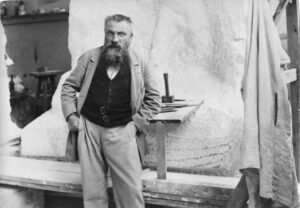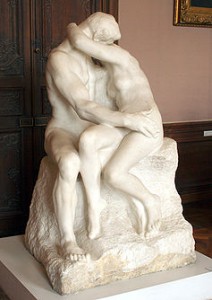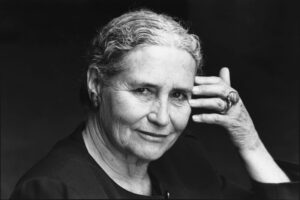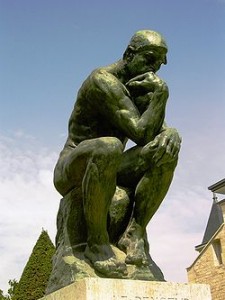#RIP #OTD in 1796 the last reigning Empress of Russia Catherine the Great died from a stroke in the Winter Palace, Saint Petersburg, age 67. Saint Peter and Paul Fortress, Saint Petersburg.
 On this day in 1917, sculptor Auguste Rodin, died at his villa in Meudon, Île-de-France, on the outskirts of Paris at the age of 77. Born François-Auguste-René Rodin on 12 November 1840 in Paris. Among his best known works: Le Penseur, La Porte de L’enfer, Monument à Balzac, Monument à Victor Hugo, Monument aux Bourgeois de Calais, L’homme qui Marche, L’age D’airain, and Le Baiser. Clearly, Le Baiser (The Kiss) is my personal favorite.
On this day in 1917, sculptor Auguste Rodin, died at his villa in Meudon, Île-de-France, on the outskirts of Paris at the age of 77. Born François-Auguste-René Rodin on 12 November 1840 in Paris. Among his best known works: Le Penseur, La Porte de L’enfer, Monument à Balzac, Monument à Victor Hugo, Monument aux Bourgeois de Calais, L’homme qui Marche, L’age D’airain, and Le Baiser. Clearly, Le Baiser (The Kiss) is my personal favorite.  The sculpture was originally titled Francesca da Rimini, as it depicts the 13th-century Italian noblewoman immortalised in Dante’s Inferno (Circle 2, Canto 5) who falls in love with her husband Giovanni Malatesta’s younger brother Paolo. They fall in love while reading the story of Lancelot and Guinevere, but the couple are discovered and killed by Giovanni. In the sculpture, the book can be seen in Paolo’s hand. The lovers lips do not actually touch in the sculpture to suggest that they were interrupted and met their demise without their lips ever having touched. In 1864 Rodin began living with Rose Beuret, with whom he would have a son. In 1883, at the age of 43, Rodin met the 18 year-old artist Camille Claudel. The two commenced a passionate but stormy relationship and they influenced each other artistically. She inspired him as a model for many of his female figures. His muse if you will. Rodin parted with Claudel in 1898.
The sculpture was originally titled Francesca da Rimini, as it depicts the 13th-century Italian noblewoman immortalised in Dante’s Inferno (Circle 2, Canto 5) who falls in love with her husband Giovanni Malatesta’s younger brother Paolo. They fall in love while reading the story of Lancelot and Guinevere, but the couple are discovered and killed by Giovanni. In the sculpture, the book can be seen in Paolo’s hand. The lovers lips do not actually touch in the sculpture to suggest that they were interrupted and met their demise without their lips ever having touched. In 1864 Rodin began living with Rose Beuret, with whom he would have a son. In 1883, at the age of 43, Rodin met the 18 year-old artist Camille Claudel. The two commenced a passionate but stormy relationship and they influenced each other artistically. She inspired him as a model for many of his female figures. His muse if you will. Rodin parted with Claudel in 1898.
Fifty-three years into their relationship, Rodin married Beuret. They married on 29 January 1917, and Beuret died two weeks later, on 16 February. Rodin was ill that year; in January, he suffered weakness from influenza, and on 16 November his physician announced that “congestion of the lungs has caused great weakness. The patient’s condition is grave.” Rodin died the next day.
A cast of The Thinker was placed next to his tomb in Meudon; it was Rodin’s wish that the figure served as his headstone and epitaph. In 1923, Marcell Tirel, Rodin’s secretary, published a book alleging that Rodin’s death was largely due to cold, and the fact that he had no heat at Meudon. Rodin requested permission to stay in the Hotel Biron, a museum of his works, but the director of the museum refused to let him stay there.
#RIP #OTD in 1992 writer, professor, philosopher, intersectional feminist, poet, civil rights activist, self-described black, lesbian, feminist, socialist, mother, warrior, poet, Audre Lorde died of breast cancer in St. Croix aged 58. Cremated remains scattered in the Caribbean
 On this day in 2006 singer, songwriter, actress, the “Queen of R&B”, Ruth Brown died in Henderson, Nevada from a heart attack and stroke, aged 78. Born Ruth Alston Weston in Portsmouth, Virginia on 12 January 1928. She was noted for bringing a pop music style to R&B music in a series of hit songs for Atlantic Records in the 1950s, such as “So Long”, “Teardrops from My Eyes” and “(Mama) He Treats Your Daughter Mean”. For these contributions, Atlantic became known as “the house that Ruth built” (alluding to the popular nickname for the old Yankee Stadium). Brown was a 1993 inductee into the Rock and Roll Hall of Fame.
On this day in 2006 singer, songwriter, actress, the “Queen of R&B”, Ruth Brown died in Henderson, Nevada from a heart attack and stroke, aged 78. Born Ruth Alston Weston in Portsmouth, Virginia on 12 January 1928. She was noted for bringing a pop music style to R&B music in a series of hit songs for Atlantic Records in the 1950s, such as “So Long”, “Teardrops from My Eyes” and “(Mama) He Treats Your Daughter Mean”. For these contributions, Atlantic became known as “the house that Ruth built” (alluding to the popular nickname for the old Yankee Stadium). Brown was a 1993 inductee into the Rock and Roll Hall of Fame.
Following a resurgence that began in the mid-1970s and peaked in the 1980s, Brown used her influence to press for musicians’ rights regarding royalties and contracts; these efforts led to the founding of the Rhythm and Blues Foundation. Her performances in the Broadway musical Black and Blue earned Brown a Tony Award, and the original cast recording won a Grammy Award. Brown was a recipient of the Grammy Lifetime Achievement Award in 2016. In 2017, Brown was inducted into National Rhythm & Blues Hall of Fame.
A memorial concert for her was held on January 22, 2007, at the Abyssinian Baptist Church in Harlem, New York. Roosevelt Memorial Park, Chesapeake City, Virginia
 And on this day in 2013 novelist Doris Lessing died at her home in London, aged 94. Born Doris May Tayler in Kermanshah, Iran, on 22 October 1919. She lived in Iran until 1925. Her family then moved to Southern Rhodesia (now Zimbabwe), where she remained until moving in 1949 to London, England. Her novels include The Grass Is Singing (1950), the sequence of five novels collectively called Children of Violence (1952–1969), The Golden Notebook (1962), The Good Terrorist (1985), and five novels collectively known as Canopus in Argos: Archives (1979–1983).
And on this day in 2013 novelist Doris Lessing died at her home in London, aged 94. Born Doris May Tayler in Kermanshah, Iran, on 22 October 1919. She lived in Iran until 1925. Her family then moved to Southern Rhodesia (now Zimbabwe), where she remained until moving in 1949 to London, England. Her novels include The Grass Is Singing (1950), the sequence of five novels collectively called Children of Violence (1952–1969), The Golden Notebook (1962), The Good Terrorist (1985), and five novels collectively known as Canopus in Argos: Archives (1979–1983).
Lessing was awarded the 2007 Nobel Prize in Literature. In awarding the prize, the Swedish Academy described her as “that epicist of the female experience, who with scepticism, fire and visionary power has subjected a divided civilisation to scrutiny”. Lessing was the oldest person ever to receive the Nobel Prize in Literature.
The Final Footprint
During the late-1990s Lessing suffered a stroke, which stopped her from travelling during her later years. She was still able to attend the theatre and opera. She began to focus her mind on death, for example asking herself if she would have time to finish a new book. She was remembered with a humanist funeral service. Lessing was cremated at Golders Green Crematorium.
Have you planned yours yet?
Follow TFF on twitter @RIPTFF



